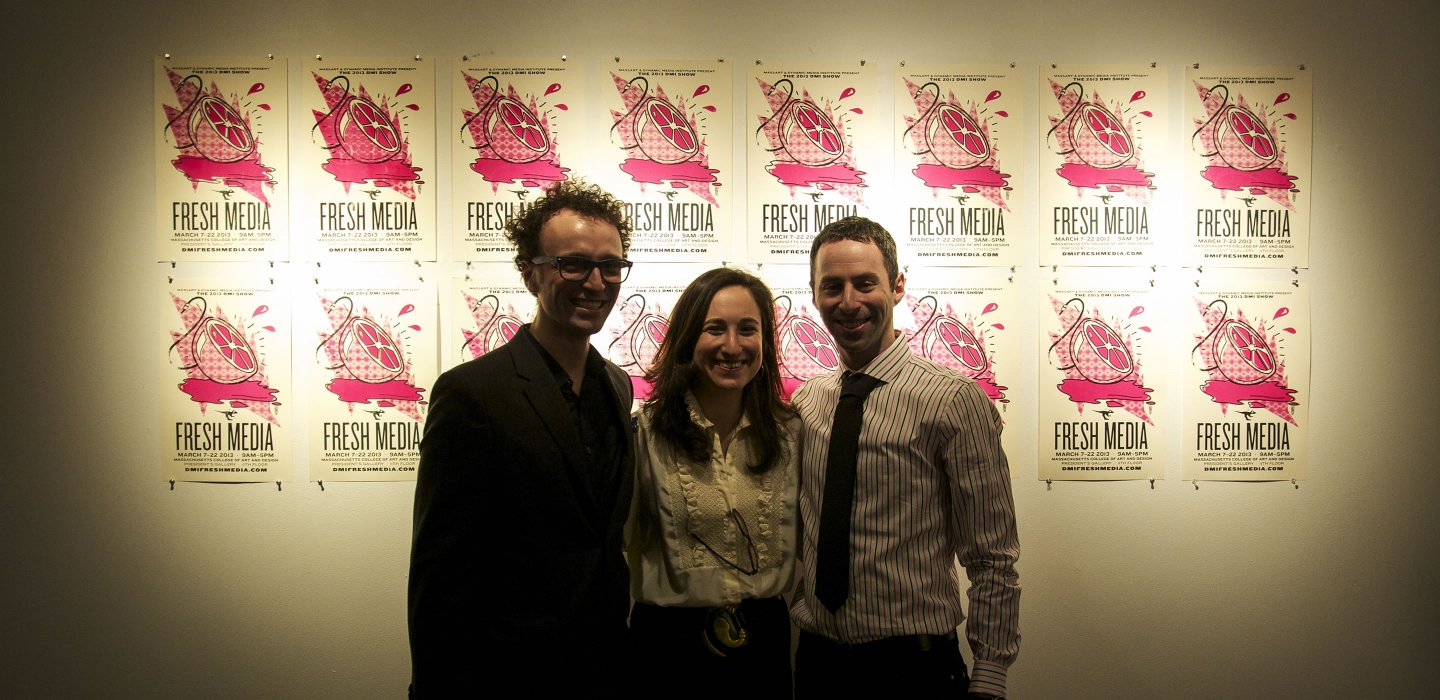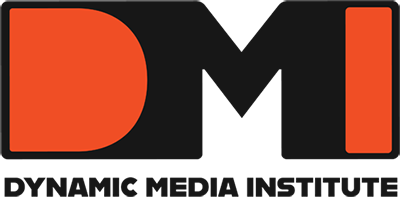
You’ll find a vibrant spirit of collaboration at DMI. Students work together on group assignments and often assist one another on thesis projects. Increasingly, we see student collaborators tackling challenging design projects that span their individual thesis interests. These opportunities, plentiful at DMI, will help you grow in remarkable new ways.
Students also frequently organize self-curated shows, giving their DMI work a wider audience in the greater MassArt and Boston community. Recent shows have included: mediaLuscious: Design + Art Review; Ordinary Human Unhappiness, Christopher Field’s thesis exhibition; Provocative Objects: the extradition, a cyberSurreal exhibit-event; and American Cheese: an introspection.
Collaborating with other students at DMI is an incredible opportunity. In our final year we began working together on a major thesis project, Collaborative Drawing, that would completely redefine our current understanding of interactive media and our individual thesis topics. Coming from separate backgrounds (fine arts and writing) we were able to push ourselves simply by observing each others strengths and weaknesses–and, more importantly, have a ton of fun along the way. This level of collaboration is one of the greatest strengths of the Dynamic Media Institute. The eclectic mix of students the program attracts, from computer programmers to film makers, fine artists, and graphic designers, provides students with an opportunity to work with a wide range of creative minds–making collaboration a no-brainer.
Jason Bailey & Dennis Ludvino (MFAs 2010)
As the fourth of four children, you’d think I was all about teamwork. After all, a large family usually means a willingness to share. As it turns out, that’s not the case with me. Perhaps it’s due to the fact that I’m the fourth by a while—just over seven years—so I ended up spending much of my childhood as a quasi-only child, the notorious non-sharer. Whatever the reason, I’ve always been hesitant.
But at the DMI, a hesitation is rarely allowed to continue as such. Within a few months of starting the program I realized that working on projects with my colleagues—almost all of whom had attended art school as undergraduates, in contrast to my business degree—was something I would have to do. None of this is to say that I had never collaborated with others before. On the contrary, working in the advertising world often requires me to consult with art directors, designers, information architects, copywriters, and others. In these cases, though, I was usually the gatekeeper: as the developer on the project it was my job to take all of the work everyone else had done, produce it as public facing, and launch it. Within the confines of art school, however, things would be a bit different.
My first foray into a collaborative effort didn’t occur until the spring semester of my first year. My colleague Daniel was tasked with producing an introduction project for a lecture to be held at MassArt, hosted by DMI. The program was celebrating its 10th anniversary and administrators wanted a way to let attendees know. Daniel and I came up with an idea that included photographing attendees as they entered the lecture hall, processing the photos digitally, and displaying them up on the large projection screen to spell out “DMI 10Y.” The idea required a bit of programming and I had been traveling earlier in the week, so development occurred at the last minute.
To be sure, I am no stranger to down-to-the-wire project launches. This time, however, there were many moving pieces for which we had not accounted: availability of Internet at the right places, the speed at which all the different required computers could process the data, and so on. In the end, none of the attendees made any remarks about the piece, negative nor positive. I, on the other hand, was beside myself, thoroughly disappointed. How could I let all of those variable go unconsidered? I had promised Daniel the project would come together and would look and function perfectly. I didn’t necessarily care that no one noticed it wasn’t working properly: I noticed the lag time, the error messages (albeit behind the scenes).
Daniel, on the other hand, didn’t seem to mind very much. Rather, he was pleased with the effort. “We’ll be able to fix those mistakes for next time.” Wait, “next time”? I had been so engrained in the commercial/agency lifestyle that it had never occurred to me that this project wasn’t necessarily the final version. I never looked at it as Daniel had, more an exercise in process than in the product. “We learned a bunch from what we did. I’m excited to give it another try next year.”
And so the collaboration wasn’t so bad. Not only had I pushed myself into a situation I had resisted in the past, but I learned a great deal more from it than I thought I would. Originally I figured I could pick up some aesthetic pointers, ways I could improve my design eye. Instead, I walked away with a greater understanding of how a designer’s mind should work, how I needed to transform my expectations and goals to come away from my work in a better place. Maybe I could work with these art school designer types, after all.
Gabi Shaffzin (MFA 2013)
“Alex, wouldn’t it be awesome if we had our own show? I mean a show where all the DMI students had the opportunity to showcase their work?” My conversation with Alex Wang, a fellow DMI student, back in November of 2010 was the inspiration for developing mediaLuscious, a DMI student show in March 2011. We were quickly joined by co-conspirator and DMI student Lou Susi, whose experience with shows and enthusiasm made this crazy idea concrete. Everybody participated and showed great team spirit in organizing the
show. More importantly, everyone was willing to collaborate — from sharing cables and tape, to soldering wires, to setting up screens, and even debugging Processing code. mediaLuscious is a great example of the importance of teamwork. We were all striving for the same goal, we all wanted to equally shine on that day, we all wanted the best for our department and peers.Tania Ostorga (MFA 2011)
